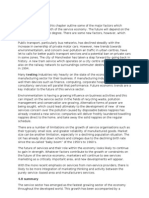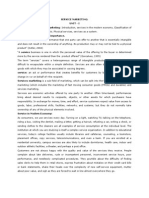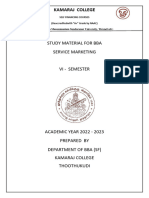Chapter One
Chapter One
Uploaded by
gebrezgi93821Copyright:
Available Formats
Chapter One
Chapter One
Uploaded by
gebrezgi93821Original Title
Copyright
Available Formats
Share this document
Did you find this document useful?
Is this content inappropriate?
Copyright:
Available Formats
Chapter One
Chapter One
Uploaded by
gebrezgi93821Copyright:
Available Formats
Mktm 3041– Service Marketing (A.
Y 2024/25)
CHAPTER ONE: INTRODUCTION TO SERVICES MARKETING
Introduction
Marketing is something that affects every one of us every waking moment of our lives – even though
we may not necessarily be conscious of it. From that very moment we stir out of deep sleep, turn on
the radio or television, and walk around the house, we are bombarded by marketing messages. They
are not always in the form of advertisements beaming from the radio or television.
In classical terms marketing can be defined as the performance of business activities that direct the
flow of goods and services from producers to consumers. This definition is too narrow to describe
marketing. It emphasizes the distribution aspect of marketing. In broader terms, on the other hand,
marketing is defined as a system of business activities designed to plan, price, distribute and promote
want satisfying products (goods and services) to present and potential customers.
In business firm marketing generates the revenues that the financial people manage and the
production people use in creating products and services. The challenge that faces marketing is to
generate those revenues by satisfying customers’ wants at a profit and in a socially responsible
manner. However, marketing is not limited to business organizations. Whenever we try to persuade
somebody to do something: donate to RED CROSS, not to litter the highways, save energy, vote for candidate,
we are engaging in marketing; thus marketing has a broad societal meaning and it is applicable not only for
profit making but also not for profit organizations.
Growth and Role of Services in the Economy
There is a growing market for services and increasing dominance of services in economies
worldwide. Services are a dominant force in countries around the world as can be seen in the global
feature. The tremendous growth and economic contributions of the service sector have drawn
increasing attention to the issues and problems of service sector industries. Services touch the lives of
every person every day whether it is in the field of food services, communication, leisure services,
maintenance services, travel, and amusement parks. Services are increasingly being used by the
corporate as well as the household sector. This emphasis on services and its increasing use has not
happened overnight - it started in the twentieth century especially after the end of World War II. Due
to large scale destruction during the war, a lot of economic activities had to be carried out to bring the
war torn economies back on road. World War II marked as milestone in the explosive rise of service
industries. In the present day world the service sector is growing at a phenomenal rate and termed as
‘sunrise sector of the economy’.
1|Page Yemane G. (PhD)
Mktm 3041 Service Marketing (A.Y 2024/25)
–
For instance: Ethiopian case: In terms of the structure of the economy, the share of services and
industry sectors in the economy is increasing in contrast to that of agriculture which is declining. For
example, in 2013/14 the shares of services, agriculture and industry stand at 46 percent, 40
percent and 14 percent, respectively. In contrast, in 2022, the share of agriculture was 37.64
percent, industry contributed approximately 22.72 percent and the services sector contributed about
36.56 percent to the national GDP (MoFED).
Why Study Services?
o Services Dominate Economy in Most Nations
o Services are growing dramatically
o Most New Jobs are Generated by Services
o Service leads to customer retention and loyalty
o Services help manufacturing companies differentiate themselves
Reasons for Growth of Services (Forces Transforming the Service Economy)
The powerful forces transforming service markets include: government policies, social changes,
business trends, advances in IT, internationalization.
1. Government Policies
It is Govt. which makes mandatory for price levels, distribution strategies, defining procedure
attributes. Another important action taken by the Govt.‟s “Privatization” means the policy of
transform companies. The transformation of such operations like telecoms, airlines has led to
restructuring cost cutting and more market focused.
2. Social Changes
2|Page Yemane G. (PhD)
Mktm 3041– Service Marketing (A.Y 2024/25)
Now a day there is a drastic change, two members are working, which requires to hire
individuals to perform tasks that used to be performed by a house hold member. E.g. Child
care, Laundry, Food preparation
3. Business Trends
Many professional associations have been forced by Govt. to remove long-standing bars on
ads and promotional activities.
Franchising has become wider spread in many service industries.
Licensing of independent entrepreneurs to produce and sell a branded service according to
tightly specified procedures.
4. Advances in IT:
Changes come from the integration of computers and tele-communication. More powerful
software enables firm to create databases that combine information about customers with
details of all their transaction, so that they can be used to predict new trends, segment the
market, new marketing opportunities. The creation of wireless networks and transfer of
electronic equipments such as cell phones to lap tops and scanners, to allow sales and
customer service personnel to keep in touch.
5. Internationalization and Globalization:
A strategy of international expansion may be driven by a sector for new markets or by the need
to respond to existing customers who are traveling abroad in greater numbers. When companies
set up operations in other countries they often prefer to deal with just a few international
suppliers rather than numerous local firms. The net effect is to increase competition and to
encourage the transfer of innovation in both products and processes from country to country.
1.1 Definition of Services
Renting a hotel room, depositing money in a bank, traveling on an airplane, visiting a psychiatrist,
getting a haircut, having a car repaired, watching a professional sport, watching a movie, having
clothes cleaned at a dry cleaners, getting advice from a lawyer – all involve buying a service.
In simple words, services are deeds, processes, and performances. But, the increasing interest in the
services sector has been accompanied by considerable disagreement and debate as to what constitutes
a service and whether service marketing is a distinctive subject area. In order to develop clarity on
service as a concept, it is desirable to look at the way various researchers and scholars have defined it
over the years.
1. One of the first to define services was the American Marketing Association which as early as
in 1960 defined services as “activities, benefits, or satisfactions which are offered for sale, or
provided in connection with the sale of goods”. This definition took a very limited view of
services as it proposed that services are offered only in connection with the sale of goods.
3|Page Yemane G. (PhD)
Mktm 3041– Service Marketing (A.Y 2024/25)
2. Another definition given by Blois in 1974 says that, “a service is an activity offered for sale
which yields benefits and satisfactions without leading to a physical change in the form of a
good”.
3. Philip Kotler and Bloom in 1984, defined service as, “any activity or benefit that one party
can offer to another that is essentially intangible and does not result in the ownership of
anything. Its production may or may not be tied to a physical product”.
We may conclude service as, “an activity or series of activities rather than things which has some
element of intangibility associated with it, which involves some interaction between the customer and
the service provider, and does not result in a transfer of ownership. Customer has a vital role to play
in the production process as the services are provided in response to the problems of customers as
solution. The production of the service may or may not be closely associated with a physical
product”.
Why Services Marketing?
Many forces led to the growth of services marketing:
> There is a growing economic importance of services
• The service sector represents a major share of GDP
• The service sector has become a major employer
• Trade in services is growing worldwide
> Services Marketing is different
• More variables exist in marketing mix of services than for consumer goods
• In a service business, marketing and operations are more closely linked than in a manufacturing
business. The service production process is part of the marketing process.
• Pricing of services is difficult because determining the costs associated with service
production and delivery is very difficult.
• The benefits of using price as a promotional weapon are not apparent in services.
Promotional price cuts tended to erode hard fought positioning and image.
1.3 Nature of Services
It is utmost important to explore the distinctive features of services, because recognition of these
special characteristics will provide insights for enlightened and innovative management. One reason
for the poor quality of service levels across different service industries is that managers often tend to
solve service marketing problems with tools and techniques that are essentially meant for tangible
products. It happens because of inadequate understanding about the nature of services. As our
knowledge of the characteristics of services grows, so does our ability to deal with them from both an
economic and marketing perspective. Services have a number of unique characteristics that make
them different from products. Specifically, services have the following key distinguishing and are the
most commonly accepted characteristics.
4|Page Yemane G. (PhD)
Mktm 3041– Service Marketing (A.Y 2024/25)
(i) Intangibility: The most basic and universally cited characteristic of services is intangibility.
Unlike tangible goods, services cannot generally be seen, tasted, felt, heard or smelled before being
consumed. Moreover, services are performances or actions rather than objects, they cannot be seen,
felt, tasted, or touched in the same manner that we can sense tangible goods. For example, when we
buy a cake of soap, we can see, feel, smell and use to check its effectiveness in cleaning. But, when
we pay fees for a semester in the university, we are paying for the benefits of deriving knowledge,
skills and education which are delivered to us by teachers. Teaching is an intangible service. When
we travel by a plane, the benefit which we are deriving is a service (transportation) but, it has some
tangible aspects such as the particular plane in which we fly (Boeing, Avro, Concorde, etc.) and the
food and drink which are served.
The broad definition of services implies that intangibility is a key determinant of whether an offering
is or is not a service. While this is true, it is also true that very few products are purely tangible or
purely intangible. Instead, services tend to be more intangible than manufactured products, and
manufactured products tend to be more tangible than services.
Implications:
Intangibility presents several marketing challenges. Services cannot be inventoried, and therefore
fluctuations in demand are often difficult to manage. It cannot be readily displayed or easily
communicated to customers, so quality may be difficult for consumers to assess. The actual costs of a
‘unit of service’ are hard to determine and the price/quality relationship is complex. Customers have
difficulty in evaluating competing services.
To help a customer picture a service prior to usage a service organization needs to provide something
tangible, e.g. computerized representation of hairstyles or a university prospectus.
(ii) Inseparability (simultaneous production and consumption): In most cases a service cannot be
separated from the person or firm providing it. A service is provided by a person who possesses a
particular skill (singer, doctor, etc.), by using equipment to handle a tangible product (dry cleaning)
or by allowing access to or use of a physical infrastructure (hotel, train, etc.). Services are typically
produced and consumed at the same time. The relationship between production and consumption,
therefore, dictates that production and marketing are highly integrated processes. . A service cannot
be put on a shelf and bought by the consumer whenever needed. The service provider must be
present. Surgery requires the presence of doctors and their equipment; checking the accuracy of a
cost records requires the presence of an auditor.
Generally, most goods are produced first, then sold and consumed. On the other hand, services are
usually sold first and produced and consumed simultaneously. Another outcome of simultaneous
5|Page Yemane G. (PhD)
You might also like
- NHAT ANH NGUYEN-SAT ADV TEST - ExamPrintReportNo ratings yetNHAT ANH NGUYEN-SAT ADV TEST - ExamPrintReport33 pages
- Service Marketing - 571073: Unit - I Introduction100% (11)Service Marketing - 571073: Unit - I Introduction47 pages
- Service Marketing Environment and Other Factors Affecting Marketing Environment83% (6)Service Marketing Environment and Other Factors Affecting Marketing Environment31 pages
- SSM Report Services Marketing EnvironmentNo ratings yetSSM Report Services Marketing Environment23 pages
- Chapter 1 - Introduction To Services: Service Marketing Week 1No ratings yetChapter 1 - Introduction To Services: Service Marketing Week 114 pages
- Service Industry Service As A Product, Customer Service, and Derived ServiceNo ratings yetService Industry Service As A Product, Customer Service, and Derived Service10 pages
- Chapter 1 - Basic Concept of Service MarketingNo ratings yetChapter 1 - Basic Concept of Service Marketing15 pages
- Unit 3 Marketing of Services: ObjectivesNo ratings yetUnit 3 Marketing of Services: Objectives19 pages
- Evolution and Growth of Service Sector - For Service Marketing75% (4)Evolution and Growth of Service Sector - For Service Marketing55 pages
- Unit 1 Introduction to service marketingNo ratings yetUnit 1 Introduction to service marketing17 pages
- Unit-1 Introduction To Service Marketing-Converted-1No ratings yetUnit-1 Introduction To Service Marketing-Converted-130 pages
- Module I Introduction To Service Sector (Sem II)No ratings yetModule I Introduction To Service Sector (Sem II)18 pages
- Achieving Competitive Advantage in Insurance IndustryNo ratings yetAchieving Competitive Advantage in Insurance Industry4 pages
- A Study BTL Seasonality Across Media and Banking and FMCG Sector in INDIANo ratings yetA Study BTL Seasonality Across Media and Banking and FMCG Sector in INDIA54 pages
- Promotional Strategies For Services in Rural Market: Dr.S.VishnuvarthaniNo ratings yetPromotional Strategies For Services in Rural Market: Dr.S.Vishnuvarthani4 pages
- T1 - Bean Jennifer, Hussey Lascelles (2012) Marketing Public Sector ServicesNo ratings yetT1 - Bean Jennifer, Hussey Lascelles (2012) Marketing Public Sector Services19 pages
- The History of PT. PLN: President SoekarnoNo ratings yetThe History of PT. PLN: President Soekarno2 pages
- Indonesia Broadband Plan (ITU Jakarta, 090915)No ratings yetIndonesia Broadband Plan (ITU Jakarta, 090915)22 pages
- Oleh: Email: Pembimbing I: Pembimbing II:: CountNo ratings yetOleh: Email: Pembimbing I: Pembimbing II:: Count17 pages
- Guided Notes Unit 5 - Macroeconomics - Economic Challenges, GDP and Growth, and LaborNo ratings yetGuided Notes Unit 5 - Macroeconomics - Economic Challenges, GDP and Growth, and Labor4 pages
- Industrial Fans Manufacturer - Electric Motors - Industrial Ceiling Fan Products Catalog of Zhongshan Gao Wei GroupNo ratings yetIndustrial Fans Manufacturer - Electric Motors - Industrial Ceiling Fan Products Catalog of Zhongshan Gao Wei Group22 pages
- Sciencedirect: Challenges of Internationalization For Smes and Overcoming These Challenges: A Case Study From TurkeyNo ratings yetSciencedirect: Challenges of Internationalization For Smes and Overcoming These Challenges: A Case Study From Turkey10 pages
- Service Marketing Environment and Other Factors Affecting Marketing EnvironmentService Marketing Environment and Other Factors Affecting Marketing Environment
- Chapter 1 - Introduction To Services: Service Marketing Week 1Chapter 1 - Introduction To Services: Service Marketing Week 1
- Service Industry Service As A Product, Customer Service, and Derived ServiceService Industry Service As A Product, Customer Service, and Derived Service
- Evolution and Growth of Service Sector - For Service MarketingEvolution and Growth of Service Sector - For Service Marketing
- Unit-1 Introduction To Service Marketing-Converted-1Unit-1 Introduction To Service Marketing-Converted-1
- Achieving Competitive Advantage in Insurance IndustryAchieving Competitive Advantage in Insurance Industry
- A Study BTL Seasonality Across Media and Banking and FMCG Sector in INDIAA Study BTL Seasonality Across Media and Banking and FMCG Sector in INDIA
- Promotional Strategies For Services in Rural Market: Dr.S.VishnuvarthaniPromotional Strategies For Services in Rural Market: Dr.S.Vishnuvarthani
- T1 - Bean Jennifer, Hussey Lascelles (2012) Marketing Public Sector ServicesT1 - Bean Jennifer, Hussey Lascelles (2012) Marketing Public Sector Services
- Guided Notes Unit 5 - Macroeconomics - Economic Challenges, GDP and Growth, and LaborGuided Notes Unit 5 - Macroeconomics - Economic Challenges, GDP and Growth, and Labor
- Industrial Fans Manufacturer - Electric Motors - Industrial Ceiling Fan Products Catalog of Zhongshan Gao Wei GroupIndustrial Fans Manufacturer - Electric Motors - Industrial Ceiling Fan Products Catalog of Zhongshan Gao Wei Group
- Sciencedirect: Challenges of Internationalization For Smes and Overcoming These Challenges: A Case Study From TurkeySciencedirect: Challenges of Internationalization For Smes and Overcoming These Challenges: A Case Study From Turkey






























































































